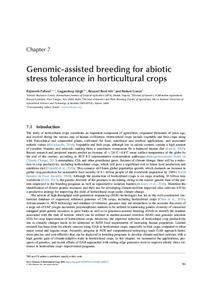| dc.contributor.author | Paliwal, R. |
| dc.contributor.author | Singh, G. |
| dc.contributor.author | Mir, R.R. |
| dc.contributor.author | Gueye, B. |
| dc.date.accessioned | 2022-05-23T15:29:43Z |
| dc.date.available | 2022-05-23T15:29:43Z |
| dc.date.issued | 2021 |
| dc.identifier.citation | Paliwal, R., Singh, G., Mir, R.R. & Gueye, B. (2021). Genomic-assisted breeding for abiotic stress tolerance in horticultural crops. In A.C. Rai, A. Rai, K.K. Rai, V.P. Rai, and A. Kumar, Stress tolerance in horticultural crops. Sawston, UK: Woodhead Publishing, (p. 91-118). |
| dc.identifier.issn | 978-0-12-822849-4 |
| dc.identifier.uri | https://hdl.handle.net/20.500.12478/7483 |
| dc.description.abstract | Horticultural crops, including fruits and vegetables, form a major source of nutrition containing minerals and vitamins for humans and have been primarily cultivated since thousands of years of domestication. Their production has crossed the 10 billion tons mark value signifying their massive demand in the market. However, they are adversely affected by various abiotic stresses such as drought, heat, salinity, and cold, which are adversely affecting their production. This highlights serious and recurrent constraints that need to be resolved to overcome yield losses and maintain global food and nutritional security. Generation of performant varieties, in terms of productivity, to these adverse conditions is, thus, an essential and tedious challenge for the crop breeders. Though traditional methods of crop breeding have been utilized to their full potential for the development of improved varieties, the limitations associated with these conventional methods, for instance, time-consuming, low efficiency, and environmental dependence have restricted their applications in crop improvement. However, with the advent of low-cost modern next-generation sequencing (NGS) technology, high-throughput genomics-assisted breeding (GAB) approaches, pace and precision have been dramatically increased for the success of crop genetic improvement programs. For instance, quantitative trait loci (QTLs) associated with abiotic stress tolerance have been identified employing linkage and association mapping approaches based on marker–trait relationships. Marker-assisted selection can then be utilized for rapid introgression of abiotic stress–resistance gene/QTLs into the genetic background of the susceptible recipient parent with enhanced accuracy than conventional methods of plant breeding. Another approach, genome-wide association studies with an advantage over linkage mapping, has been successfully implemented to identify the SNPs conferring abiotic stress–resistance in crops. Likewise, genomic selection with an edge over QTL mapping is the preferred method for the estimation of breeding values by utilizing all available molecular markers in combination with phenotypic data. Similarly, whole-genome sequencing following NGS-based technologies aids in the identification of the genomic-regions governing complex stress tolerance–related traits. The information provided in this chapter will be useful for understanding the GAB approaches utilized with cutting-edge molecular tools in crop-improvement programs, highlighting abiotic stress–related traits and studies from various economically important horticultural crops. |
| dc.format.extent | 91-118 |
| dc.language.iso | en |
| dc.publisher | Woodhead Publishing |
| dc.subject | Climate Change |
| dc.subject | Quantitative Trait Loci |
| dc.subject | Genomics |
| dc.subject | Marker-Assisted Selection |
| dc.subject | Breeding |
| dc.subject | Abiotic Stress |
| dc.title | Genomic-assisted breeding for abiotic stress tolerance in horticultural crops |
| dc.type | Book Chapter |
| cg.contributor.crp | Genebanks |
| cg.contributor.affiliation | International Institute of Tropical Agriculture |
| cg.contributor.affiliation | Indian Agricultural Research Institute |
| cg.contributor.affiliation | Sher-e-Kashmir University of Agricultural Sciences and Technology of Kashmir |
| cg.coverage.hub | Headquarters and Western Africa Hub |
| cg.researchtheme | Biotech and Plant Breeding |
| cg.identifier.bibtexciteid | PALIWAL:2021a |
| cg.authorship.types | CGIAR and developing country institute |
| cg.iitasubject | Agronomy |
| cg.iitasubject | Bioscience |
| cg.iitasubject | Climate Change |
| cg.iitasubject | Plant Breeding |
| cg.iitasubject | Plant Production |
| cg.notes | Published online: 21 May 2021 |
| cg.publicationplace | Sawston, UK |
| cg.accessibilitystatus | Limited Access |
| cg.reviewstatus | Peer Review |
| cg.usagerightslicense | Copyrighted; all rights reserved |
| cg.targetaudience | Scientists |
| cg.identifier.doi | https://dx.doi.org/10.1016/b978-0-12-822849-4.00007-3 |
| cg.iitaauthor.identifier | Badara GUEYE: 0000-0003-3157-8772 |
| cg.futureupdate.required | No |

